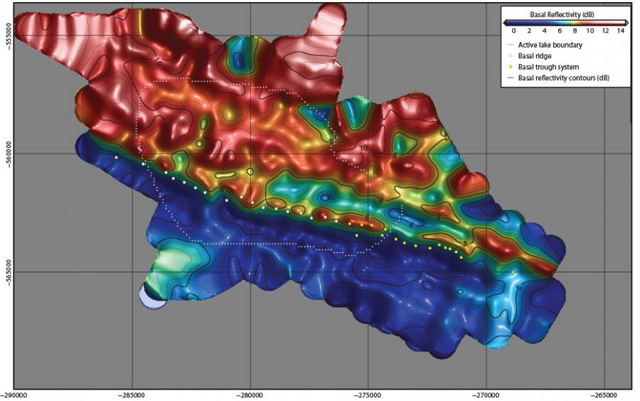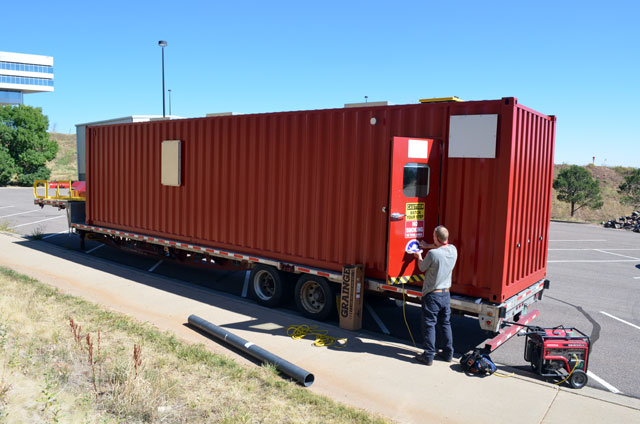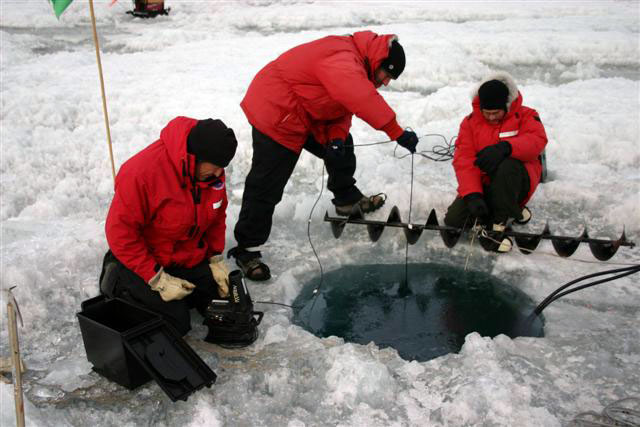|
Page 3/3 - Posted November 9, 2012
Keep in cleanThe scientists certainly aren’t playing around when it comes to keeping Lake Whillans and the rest of the subglacial system below the ice sheet from contamination. “It’s a serious issue, but it does add huge complexities to the whole operation as well,” said Powell, whose team had to develop instruments that could be cleaned and sanitized before descending into the borehole. Of course, the motivation to maintain the pristine environment is equal parts conservation and research-driven. “Many of these challenges are not just unique to the WISSARD project. They’re common to all subglacial access [projects],” said Brent Christner 
Graphic Credit: WISSARD.org
Map of the Lake Whillans bed reflectivity as measured by radar. Brighters colors like red indicated water; blue is dry.
Christner said WISSARD is using proven technologies from the food and pharmaceutical industries. Water entering the borehole will pass through filtration modules, as well as be subjected to ultraviolet radiation and pasteurization. That should take care of about 99.99 percent of the cells in the water, he said. “We actually passed E. Coli cultures through this system to ensure the system killed or removed them,” he said. The hotwater drill equipment and science instruments will also be treated to eliminate particles and microbes from reaching the lake water. “We do not want to alter these systems by either introducing microbiological or chemical contamination that will change the properties of these pristine subglacial environments,” Christner emphasized. Taking a closer lookWhat that environment looks like and its properties will be assessed by a variety of instruments that have been developed or modified specifically for the WISSARD program. One key piece of equipment is called the Micro-Submersible Lake Exploration Device (MSLED), a slim submersible designed by collaborator Alberto Behar at NASA’s Jet Propulsion Laboratory (JPL) “This is a piece of equipment that I’m very excited about,” Tulaczyk said. He explained the imagery collected by MSLED will be important for examining the morphology of the lake basin to understand how it was formed and its origin. It will also help answer questions from the age of the basin to how the water is entering and leaving the lake. “All of these questions can be addressed by that camera on MSELD,” Tulaczyk said. Getting real in situ water samples to analyze and to make a variety of measurements down through the lake water column will fall to a suite of instruments known by yet another acronym, IPSIE, for Instrument Package for Sub-Ice Exploration. The IPSIE suite is based on the sort of instruments used by oceanographers and limnologists to measure various properties of seawater, such as salinity and temperature. In this case, however, the various sensors and water-collection bags have to be stacked vertically to slip through the 800-meter-deeep, 30-centimeter-wide borehole in the ice sheet. “That’s required a bit of technology development – just trying to design it so all of the instruments can be linked to each other and synchronized,” Powell said. The various instrument units can be swapped and reordered depending on the science goals, according to Powell. The unit at the very bottom features a water pump that can circulate lake water through the instruments above. A fiber optic cable allows the team to send instructions to the instruments down in the lake cavity while their data are streaming real-time to the surface. A crane will be on site to help raise and lower the instrument suite. Getting the dirtWater isn’t the only sample the scientists hope to draw out from nearly a kilometer below the ice sheet. They want to get a little dirty, too. That will require various coring instruments to collect sediments from the lake floor. Shallow cores will capture water at the crucial interface between the water and top layer of sediments, where biological activity may occur. Longer cores up to five meters long will capture a glaciological and geological record that researchers hope pushes past the Last Glacial Maximum (LGM), when the ice sheets reached their most recent maximum extent about 20,000 years ago. Powell said there is some reason to speculate the sedimentary record may dip into the last ice age and to a previous warm period known as an interglacial about 120,000 or so years ago. 
Photo Credit: Peter Rejcek
Carpenter Graham Love puts the finishing touches on one of the two WISSARD science labs near Denver, Colo., before it was shipped to Antarctica.
“We don’t know what sort of record we’ll get,” he said. “The intriguing thing there is that it relates to the sensitivity of the West Antarctic Ice Sheet. When did it last retreat? When was it fully gone? That’s what we’re hoping to address with the longer record.” Such records are hard to obtain in the continental margin where the WISSARD team will core because of the hard glacial till that resists traditional coring techniques, according to Powell. In response, the team developed a new technology, a percussion corer, which uses a 1,000-kilogram weight to drive the core barrel into the lake floor. “It pounds its way into the sediment,” Powell said. A hydraulic motor that runs the weight can the be switch to pump water into a narrow space within the core barrel to help eject the instrument when it has collected the mud, rock and till. Learning moreThe window for this ambitious project is about two weeks in January 2013. The WISSARD camp will be a busy place during that time, with more than 40 people expected to be in the field at once. Aircraft will be coming and going. A handful of journalists and teachers will also be on site to communicate the results of the project to the world. And results are expected to come quickly, if the lake can be penetrated safely and cleanly. Two high-tech labs, built from shipping containers, will be on site for the researchers to use to analyze water and sediment samples. “We’ll be able to bring the samples up and immediately start cultures, and rate measurements. We’ll be able to do it right there,” Priscu said. A second field season is planned for 2013-14, with the focus shifting to the subglacial system that feeds and drains Lake Whillans. A proposal is pending with the NSF to support a succession of the RAGES project in future years. But this year the WISSARD team has one goal: Drilling into Lake Whillans, one of the last remaining mysteries of polar science. “We don’t know what’s there. We don’t know what to expect. What if it’s all mud? We don’t know,” Priscu said. “We know more about going to Mars.” NSF-funded research in this story: John Priscu, Mark Skidmore and Andrew Mitchel, Montana State University, Award No. 0838933 |



For USAP Participants |
For The Public |
For Researchers and EducatorsContact UsU.S. National Science FoundationOffice of Polar Programs Geosciences Directorate 2415 Eisenhower Avenue, Suite W7100 Alexandria, VA 22314 Sign up for the NSF Office of Polar Programs newsletter and events. Feedback Form |


